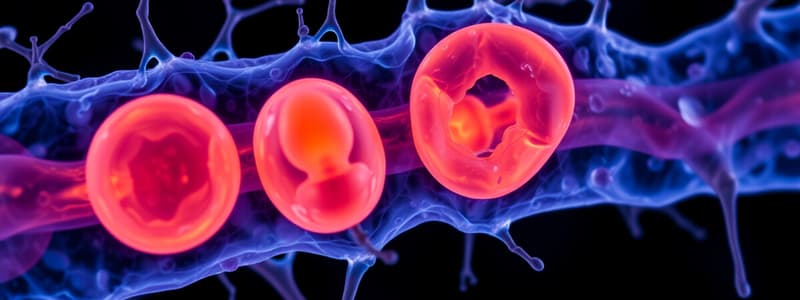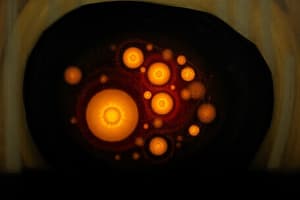Podcast
Questions and Answers
What is the primary function of ATP produced by mitochondria?
What is the primary function of ATP produced by mitochondria?
- Serving as the energy currency of the cell (correct)
- Transporting nutrients within the cell
- Facilitating cell division
- Decomposing waste products
What distinguishes apoptosis from necrosis?
What distinguishes apoptosis from necrosis?
- Apoptosis is a controlled process, whereas necrosis is chaotic and often caused by disease (correct)
- Apoptosis results from viral infections, while necrosis does not
- Apoptosis occurs only in rapidly dividing cells, while necrosis can affect any cell type
- Apoptosis leads to the release of toxins, while necrosis promotes cell health
How do mitochondria inherit their DNA?
How do mitochondria inherit their DNA?
- Exclusively from the mother (correct)
- Through random genetic recombination
- Exclusively from the father
- From both parents equally
What is generated within the mitochondrial matrix?
What is generated within the mitochondrial matrix?
Which of the following is a function of the outer mitochondrial membrane?
Which of the following is a function of the outer mitochondrial membrane?
What role do cristae play in mitochondrial function?
What role do cristae play in mitochondrial function?
Which process occurs in the inner mitochondrial membrane?
Which process occurs in the inner mitochondrial membrane?
What is the fate of mature mammalian red blood cells in relation to mitochondria?
What is the fate of mature mammalian red blood cells in relation to mitochondria?
What does the term 'semi-autonomous' imply regarding mitochondria?
What does the term 'semi-autonomous' imply regarding mitochondria?
Which protein is involved in heat production in mitochondria?
Which protein is involved in heat production in mitochondria?
What phenomenon does the term 'proton motive force' refer to?
What phenomenon does the term 'proton motive force' refer to?
Which of the following correctly describes necrosis?
Which of the following correctly describes necrosis?
What is a major characteristic of mitochondrial DNA?
What is a major characteristic of mitochondrial DNA?
What is the primary reason liver cells, or hepatocytes, have a high number of mitochondria?
What is the primary reason liver cells, or hepatocytes, have a high number of mitochondria?
Flashcards are hidden until you start studying
Study Notes
Mitochondria Overview
- "Mitochondria" derives from Greek, meaning grain-like; singular form is "mitochondrion".
- Known as the powerhouse of the cell, crucial for energy production.
Mitochondrial Structure
- Double membrane-bound organelle with an outer and inner membrane.
- Intermembrane space exists between the two membranes; inner membrane has folds called cristae.
- The interior is called the matrix, housing enzymes for the TCA cycle.
Energy Production
- Primary function is to produce ATP (adenosine triphosphate), the energy currency of cells.
- ATP synthesis occurs via the electron transport chain, also known as oxidative phosphorylation.
- Protons are pumped from the matrix into the intermembrane space, creating proton motive force that drives ATP synthase.
Mitochondrial Functions
- Besides ATP production, mitochondria play roles in:
- Apoptosis initiation (programmed cell death).
- Cell signaling and differentiation.
- Regulation of the cell cycle and growth.
- Heat production via the protein thermogenin in brown adipose tissue.
- Heme synthesis.
Genetic Information
- Mitochondria contain their own circular DNA, resembling bacterial DNA.
- Mitochondrial DNA is inherited exclusively from the mother through the ovum during fertilization.
Cell Types and Mitochondrial Content
- Mature mammalian red blood cells lack both a nucleus and mitochondria.
- Hepatocytes (liver cells) contain over 2,000 mitochondria per cell to meet high energy demands.
Distinction Between Apoptosis and Necrosis
- Apoptosis: Controlled, healthy cell death process, enabling regeneration.
- Necrosis: Pathological cell death resulting from disease or injury, considered "cell murder".
Key Takeaways
- Dysfunctional mitochondria can lead to diseases passed from mother to offspring, as paternal mitochondria do not contribute to the zygote.
- Mitochondria are essential not only for energy but also for maintaining cellular health and functions.
Studying That Suits You
Use AI to generate personalized quizzes and flashcards to suit your learning preferences.



